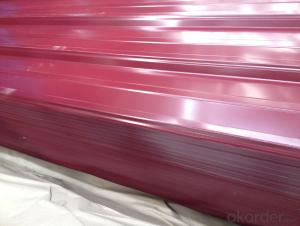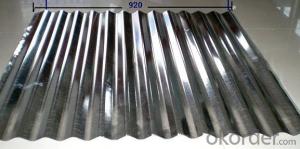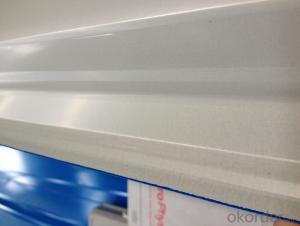Pre-Painted Galvanized Corrugated Steel---Red
- Loading Port:
- Shanghai
- Payment Terms:
- TT OR LC
- Min Order Qty:
- 100 m.t.
- Supply Capability:
- 10000 m.t./month
OKorder Service Pledge
OKorder Financial Service
You Might Also Like
1. Pre-Painted GI/GL Steel Coil Description:
With GI as base material, after pretreatment (degrease and chemical treatment ) and liquid dope with several layers of color, then after firing and cooling, finally the plate steel is called pre-painted galvanized (aluzinc) steel. Pre-painted galvanized steel is good capable of decoration, molding, corrosion resistance. It generally displays superior workability, durability and weather resistance.
2.Main Features of the Pre-Painted GI/GL Steel Coil:
• Excellent process capability
• Smooth and flat surface
• Workability, durability
• Excellent heat resistance performance
• High strength
• Good formability
• Good visual effect
3.Pre-Painted GI/GL Steel Coil Images

4.Pre-Painted GI/GL Steel Coil Specification
Standard: AISI, ASTM, BS, DIN, GB, JIS
Grade: DX51D, DX52D
Thickness: 0.17-2.0mm
Brand Name: KMRLON
Model Number: coil
Type: Steel Coil
Technique: Cold Rolled
Surface Treatment: Coated
Application: Boiler Plate
Special Use: High-strength Steel Plate
Width: 20-1250mm
Length: customized
commoidty: pre-painted galvanized steel coil
Thickness: 0.13-4.0mm
width: 20-1250mm
zinc coating: 40-180g/m2
printing thickness: top side: 20+/-5 microns, back side: 5-7 microns
color: all RAL color
surface treatment: color coated
coil weight: 4-7 tons
coil ID: 508/610mm
packaging: standard seaworthy packing
5.FAQ of Pre-Painted GI/GL Steel Coil
1. What’s the application of this product?
Roof, roof structure, surface sheet of balcony, frame of window, etc.
2. What’s the brand of the paint?
We use the best brand of all of the word—AKZO.
3. How to guarantee the quality of the products?
We have established the international advanced quality management system,every link from raw material to final product we have strict quality test;We resolutely put an end to unqualified products flowing into the market. At the same time, we will provide necessary follow-up service assurance.
4. How long can we receive the product after purchase?
Usually within thirty working days after receiving buyer’s advance payment or LC. We will arrange the factory manufacturing as soon as possible. The cargo readiness usually takes 15-25 days, but the shipment will depend on the vessel situation.
- Q: Why can steel HPB300, steel plate without Q300, steel structure manuscript review, but also continued the Q235, why not improve it?
- Carbon steel according to the steel yield strength is divided into 5 grades: Q195, Q215, Q235, Q255 and Q275 of each grade because the quality is divided into A, B, C, D grade, with a maximum of four kinds, some only one; this is just plain carbon steel, the price is cheap, generally not heat treatment. Only quality carbon steel has the value of heat treatment.
- Q: Are steel sheets suitable for railway or transportation infrastructure?
- Yes, steel sheets are suitable for railway or transportation infrastructure. Steel is a durable and strong material that can withstand heavy loads and provide stability to railway tracks and transportation structures. It is commonly used in the construction of bridges, tunnels, and rail lines due to its high strength-to-weight ratio and resistance to corrosion. Additionally, steel sheets can be easily fabricated and installed, making them a practical choice for such infrastructure projects.
- Q: What is the difference between a perforated and non-perforated steel sheet?
- The main difference between a perforated and non-perforated steel sheet lies in their respective designs and functionalities. A perforated steel sheet is characterized by having small holes or perforations evenly distributed throughout its surface. These holes can be of different shapes and sizes, depending on the specific application requirements. The primary purpose of a perforated steel sheet is to allow for the passage of air, light, sound, and liquids through the sheet, while still maintaining its structural integrity. This makes it highly suitable for applications where ventilation, filtration, or visibility is essential. Perforated steel sheets are commonly used in industries such as architecture, automotive, manufacturing, and construction, where they are employed for various purposes, including acoustic panels, protective barriers, decorative elements, and filter screens. On the other hand, a non-perforated steel sheet does not have any holes or perforations on its surface. It is a solid sheet of steel that is typically used for applications where strength, durability, and resistance to impact or abrasion are important factors. Non-perforated steel sheets are often utilized in structural engineering, machinery, shipbuilding, and heavy-duty equipment manufacturing, as they provide a solid and reliable surface for load-bearing and other demanding applications. In summary, the difference between a perforated and non-perforated steel sheet lies in their design and functionality. Perforated steel sheets have small holes throughout their surface, allowing for the passage of air, light, sound, and liquids, while non-perforated steel sheets are solid sheets without any holes, providing strength and durability for heavy-duty applications.
- Q: Are steel sheets available in different colors?
- Yes, steel sheets are available in different colors.
- Q: What is the typical lead time for steel sheet orders?
- Various factors, such as order quantity, size, steel sheet availability, and supplier location, can affect the typical lead time for steel sheet orders. Generally, lead times can range from a few days to several weeks. For smaller orders or readily available steel sheets, the lead time is usually shorter, typically around a week or less. This is because suppliers typically have these items in stock and ready for immediate shipment upon receiving an order. Conversely, larger or custom orders may require additional production time, resulting in longer lead times. This is due to the need for the supplier to manufacture the steel sheets according to the specific order requirements, which can take several weeks depending on the complexity and volume. It is important to consider that external factors like market demand, transportation delays, or unforeseen circumstances can also impact lead times. Therefore, it is advisable to directly communicate with the supplier to obtain an accurate estimation of the lead time for a specific steel sheet order.
- Q: How do you measure the thickness of steel sheets?
- One common way to measure the thickness of steel sheets is by using a tool called a micrometer. This handheld device uses a calibrated screw mechanism to accurately measure the thickness of the sheet by exerting pressure on it and providing a precise reading in millimeters or inches. Another method is to use ultrasonic thickness gauges, which emit high-frequency sound waves through the sheet and measure the time it takes for the waves to bounce back. This measurement is then converted into thickness readings.
- Q: What is the process of etching designs on steel sheets?
- The process of etching designs on steel sheets typically involves applying an acid-resistant material, such as a wax or resist, to the surface of the steel. The desired design is then drawn or transferred onto the resist. The steel sheet is then immersed in an acid bath, where the acid etches away the exposed areas of the metal, leaving behind the desired design. After etching, the resist is removed, and the steel sheet may undergo additional treatments such as cleaning, polishing, or coating to enhance the appearance and durability of the etched design.
- Q: Can steel sheets be used in the defense industry?
- The defense industry commonly utilizes steel sheets, as they are a versatile and strong material. For many years, steel has been employed in various defense applications. Armored vehicles, tanks, naval ships, and aircraft carriers are all manufactured using steel sheets. These sheets offer exceptional protection against ballistic threats like bullets and shrapnel, owing to their durability and high strength. Moreover, steel sheets can reinforce buildings and structures in military bases, enhancing security and protection. In addition, defense equipment, including weapons, ammunition, and missile components, are produced using steel sheets. Overall, steel sheets are crucial in the defense industry, as they provide reliability and resistance against high impact forces.
- Q: Can steel sheets be used for water storage tanks?
- Yes, steel sheets can be used for water storage tanks. Steel is a durable and strong material that is commonly used in the construction of water storage tanks. It is resistant to corrosion and can withstand harsh weather conditions, making it an ideal choice for long-term water storage.
- Q: Are steel sheets suitable for playground equipment?
- Indeed, playground equipment can be made using steel sheets. Steel is a robust and enduring substance that can endure extensive use, offering a secure playing environment for children. Steel sheets are versatile and can be utilized to build an array of playground equipment, ranging from slides to climbing structures and swing sets. Moreover, steel is impervious to weather conditions, rendering it an ideal selection for outdoor playgrounds. The material can be effortlessly molded and formed into various designs, providing room for innovation and personalization in playground equipment. All in all, steel sheets are a dependable and enduring choice for playground equipment, guaranteeing children's safety and enjoyment.
Send your message to us
Pre-Painted Galvanized Corrugated Steel---Red
- Loading Port:
- Shanghai
- Payment Terms:
- TT OR LC
- Min Order Qty:
- 100 m.t.
- Supply Capability:
- 10000 m.t./month
OKorder Service Pledge
OKorder Financial Service
Similar products
Hot products
Hot Searches
Related keywords




























